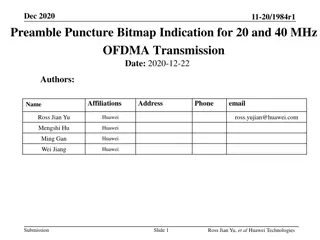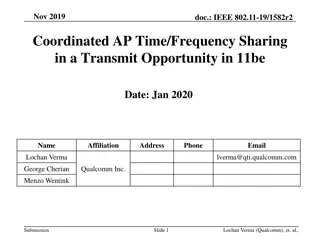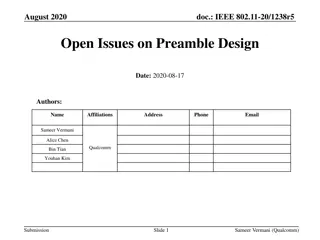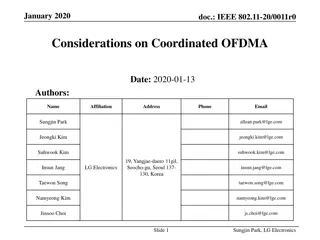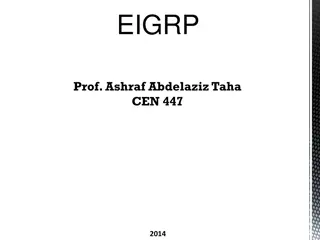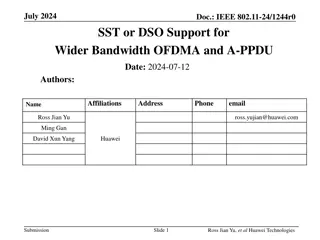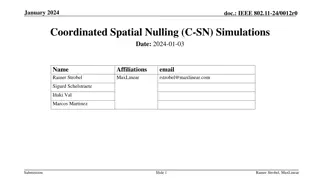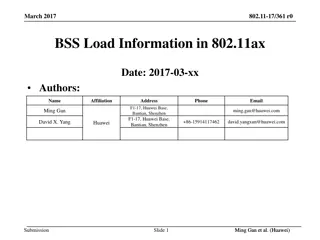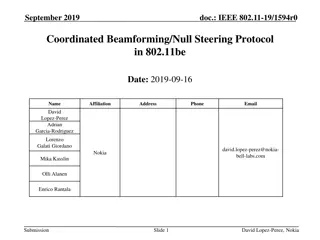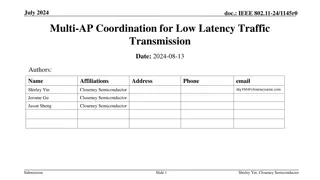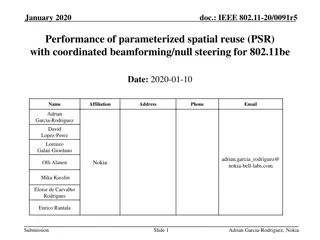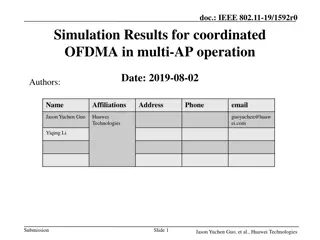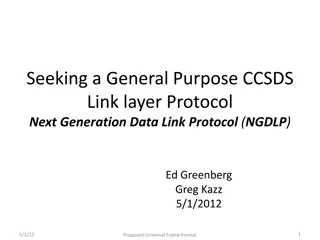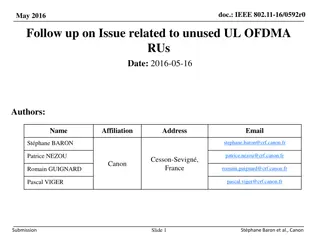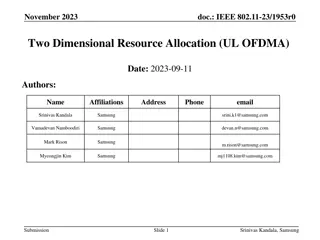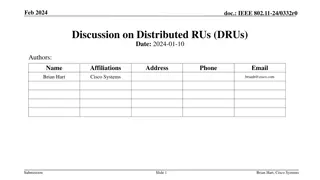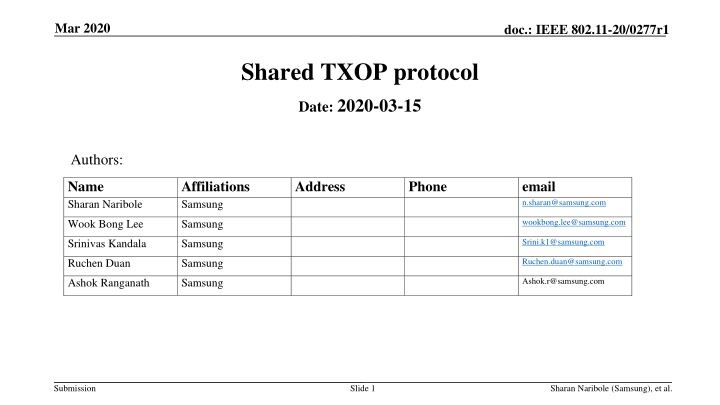
IEEE 802.11-20/0277r1 Shared TXOP Protocol Overview
Explore the IEEE 802.11-20/0277r1 Shared TXOP protocol introduced in March 2020 by Samsung experts. The protocol focuses on multi-AP coordination, AP candidate sets, shared AP selection, and coordination for Shared TXOP operation within wireless networks. Learn about the capabilities, coordination mechanisms, and AP interactions outlined in the documentation.
Download Presentation

Please find below an Image/Link to download the presentation.
The content on the website is provided AS IS for your information and personal use only. It may not be sold, licensed, or shared on other websites without obtaining consent from the author. If you encounter any issues during the download, it is possible that the publisher has removed the file from their server.
You are allowed to download the files provided on this website for personal or commercial use, subject to the condition that they are used lawfully. All files are the property of their respective owners.
The content on the website is provided AS IS for your information and personal use only. It may not be sold, licensed, or shared on other websites without obtaining consent from the author.
E N D
Presentation Transcript
Mar 2020 doc.: IEEE 802.11-20/0277r1 Shared TXOP protocol Date:2020-03-15 Authors: Name Sharan Naribole Affiliations Samsung Address Phone email n.sharan@samsung.com wookbong.lee@samsung.com Wook Bong Lee Samsung Srini.k1@samsung.com Srinivas Kandala Samsung Ruchen.duan@samsung.com Ruchen Duan Samsung Ashok.r@samsung.com Ashok Ranganath Samsung Submission Slide 1 Sharan Naribole (Samsung), et al.
Mar 2020 doc.: IEEE 802.11-20/0277r1 Introduction Several motions passed in January meeting on multi-AP topic [1] An EHT AP supporting the Multi-AP coordination can send a frame (e.g., Beacon or other management frame) including capabilities of Multi-AP transmission schemes Sharing AP o An EHT AP which obtains a TXOP (802.11 transmission opportunity) and initiates the Multi- AP coordination Shared AP o An EHT AP which is coordinated for the Multi-AP transmission by the Sharing AP 802.11be shall define a mechanism to o determine whether an AP is part of an AP candidate set and o can participate as a shared AP in coordinated AP transmission initiated by a sharing AP In this contribution, we focus on the AP candidate set, shared AP selection and coordination for Shared TXOP operation Submission Slide 2 Sharan Naribole (Samsung), et al.
Mar 2020 doc.: IEEE 802.11-20/0277r1 Multi-AP Coordination AP Candidate Set For simplicity, we refer to o Sharing AP: AP shall have capability to initialize multi-AP Coordination o Shared AP: AP shall have capability to participate in multi-AP Coordination Sharing AP shall advertise its multi-AP Coordination capability (e.g. in Beacons) o Accordingly, other APs can request to be part of its AP Candidate Set Each Sharing AP maintains an AP Candidate Set o AP Candidate Set may be different for each multi-AP transmission mode supported by the Sharing AP due to requirements of BSS operation, coordination complexity, etc. An AP can be part of AP Candidate Set of multiple Sharing APs Submission Slide 3 Sharan Naribole (Samsung), et al.
Mar 2020 doc.: IEEE 802.11-20/0277r1 Shared TXOP operation - Recap APs part of AP Candidate Set can request for resources from Sharing AP Upon obtaining TXOP, Sharing AP determines if it shares TXOP with one or more APs (shared APs) from its AP candidate set. We denote this TXOP as Shared TXOP (SH-TXOP) Sharing AP initiates SH-TXOP by transmitting SH-TXOP Announcement frame o Announcement frame transmitted in non-HT Duplicate PPDU on every 20 MHz channel of the obtained TXOP bandwidth. Shared APs may not have primary 20 MHz coinciding with the primary 20 MHz of sharing AP o Announcement frame includes frequency resource, temporary primary channel of each shared AP, lengths, and additional TXVECTOR parameters for DL and UL transmission o Sharing AP does not allocate the RUs for the STAs associated with the shared APs Each AP assigns RUs to its associated STAs, existing RU allocation procedures for non-associated STAs o UL and DL TX alignment may be required across APs to mitigate adjacent channel interference Submission Slide 4 Sharan Naribole (Samsung), et al.
Mar 2020 doc.: IEEE 802.11-20/0277r1 Shared TXOP operation example Sharing AP operating on 80 MHz Shared AP operates on the same 80 MHz on different primary 20 MHz channel Sharing AP transmits SH-TXOP Announcement in Non-HT Duplicate PPDU format Downlink transmissions begin after SIFS Followed by UL OFDMA acknowledgement and data transmissions Sharing AP Shared AP Submission Slide 5 Sharan Naribole (Samsung), et al.
Mar 2020 doc.: IEEE 802.11-20/0277r1 Selection Rules for AP Candidate Set and Shared AP In previous example, if the Shared AP operated on 160 MHz instead of 80 MHz. And, its primary 20 MHz lied outside of the Sharing AP s TXOP BW o Shared AP would not receive the SH-TXOP announcement frame Proposed rules o Primary 20 MHz of an AP part of a Sharing AP s AP Candidate Set shall lie within the BSS operating bandwidth of that Sharing AP. o Primary 20 MHz of a Shared AP shall lie within the SH-TXOP bandwidth. o Sharing AP shall not allocate to any Shared AP time-frequency resources beyond the duration of SH-TXOP and outside of corresponding SH-TXOP bandwidth. AP Candidate Set should be updated when a Shared AP performs channel switch to a primary channel outside of Sharing AP s BSS operation bandwidth. Submission Slide 6 Sharan Naribole (Samsung), et al.
Mar 2020 doc.: IEEE 802.11-20/0277r1 Primary Channel Switch by Shared APs In Shared TXOP, one or more Shared APs may have to switch their primary 20 MHz channel temporarily until the end of sh-TXOP o Primary 20 MHz of shared AP coincides with that of sharing AP or other shared APs Such Shared APs need to indicate temporary channel switch to associated EHT STAs o STAs may not hear SH-TXOP Announcement frame from Sharing AP being out of coverage o Center Frequency and BSS operating bandwidth remain the same Sharing AP Shared AP Submission Slide 7 Sharan Naribole (Samsung), et al.
Mar 2020 doc.: IEEE 802.11-20/0277r1 SH-TXOP Switch Transmission and Contents Proposal SH-TXOP Switch transmitted simultaneously by shared APs shall be identical o To avoid collision at STAs SH-TXOP Switch transmitted in non-HT Duplicate PPDU format by Shared AP on each 20 MHz channel of its BSS operation within the SH-TXOP bandwidth Even Shared AP not performing primary channel switch transmits SH-TXOP Switch o To retain channel access and prevent STAs from transmitting SH-TXOP Announcement frame shall include information whether SH-TXOP Switch frame shall be transmitted Sharing AP may not transmit SH-TXOP Switch o As its STAs hear SH-TXOP Announcement Duration field in SH-TXOP Switch set to end of SH-TXOP for legacy STAs NAV update SH-TXOP switch shall include only information essential for EHT STAs of shared AP(s) o Primary channel and bandwidth, more contents TBD Submission Slide 8 Sharan Naribole (Samsung), et al.
Mar 2020 doc.: IEEE 802.11-20/0277r1 SH-TXOP Switch Example with multiple Shared APs Sharing AP and two Shared APs operate on the same primary 20 MHz channel Sharing AP includes the two Sharing APs in the SH-TXOP Announcement Both the Shared APs simultaneously transmit the identical SH-TXOP Switch Sharing AP and Shared APs conduct the DL and UL transmissions Shared APs switch back to the primary channel prior to SH-TXOP Submission Slide 9 Sharan Naribole (Samsung), et al.
Mar 2020 doc.: IEEE 802.11-20/0277r1 SH-TXOP Switch Frame Address and Security STAs associated to different shared APs need to decrypt the identical SH-TXOP Switch SH-TXOP Switch Security context establishment Scalability issue o STAs would have have to generate temporal keys with Sharing AP o When AP joins an AP Candidate Set, each STA has to generate the keys with Sharing AP SH-TXOP Announcement and SH-TXOP Switch can be Control frames or unprotected management frames We prefer Control format as they are usually processed in the lower MAC New Trigger frame type SH-TXOP Switch MAC Header o TA includes Sharing AP s MAC address. SH-TXOP Switch does not solicit any response! o An AP can share a priori (e.g. during association) with associated EHT STAs the MAC address of Sharing AP whose AP Candidate Set this AP is part of o EHT STAs decode the SH-TXOP Switch with TA equal to Sharing AP s MAC address Submission Slide 10 Sharan Naribole (Samsung), et al.
Mar 2020 doc.: IEEE 802.11-20/0277r1 Summary Rules for AP inclusion in AP Candidate Set for Shared TXOP operation Rules for Shared AP selection from AP Candidate Set for Shared TXOP operation Contents of Announcement frame to initiate Shared TXOP Frame contents for temporary primary channel switch during Shared TXOP Security and Addressing considerations for frames enabling Shared TXOP operation Submission Slide 11 Sharan Naribole (Samsung), et al.
Mar 2020 doc.: IEEE 802.11-20/0277r1 Straw Poll #1 Do you support the addition of following text to the TGbe SFD: Shared TXOP (SH-TXOP): A TXOP in which Sharing AP grants time-frequency resources to Shared AP(s). Primary 20 MHz of an AP belonging to a Sharing AP s AP Candidate Set shall be within the BSS operating bandwidth of that Sharing AP. Primary 20 MHz of a Shared AP shall be within the TXOP bandwidth obtained by Sharing AP. Sharing AP shall not allocate to any Shared AP time-frequency resources beyond the duration of SH-TXOP and outside of corresponding SH-TXOP bandwidth. Submission Slide 12 Sharan Naribole (Samsung), et al.
Mar 2020 doc.: IEEE 802.11-20/0277r1 Straw Poll #2 Do you support the addition of following text to the TGbe SFD: In Coordinated OFDMA, primary 20 MHz of an AP belonging to Sharing AP s AP Candidate Set may be same as primary 20 MHz of the Sharing AP. Submission Slide 13 Sharan Naribole (Samsung), et al.
Mar 2020 doc.: IEEE 802.11-20/0277r1 Straw Poll #3 Do you support the addition of following text to the TGbe SFD: 802.11be shall define a mechanism for Shared AP to temporarily perform channel switch until the end of SH-TXOP. Submission Slide 14 Sharan Naribole (Samsung), et al.
Mar 2020 doc.: IEEE 802.11-20/0277r1 References [1] 11-19-1262-07-00be-specification-framework-for-tgbe [2] 11-19-1788-01-00be-coordinated-ofdma-operation Submission Slide 15 Sharan Naribole (Samsung), et al.
Mar 2020 doc.: IEEE 802.11-20/0277r1 Straw Poll #4 Do you support the addition of following text to the TGbe SFD: 802.11be shall define an SH-TXOP Announcement frame, a new frame type which will be transmitted by a Sharing AP to initiate a SH-TXOP. o SH-TXOP Announcement can be a new Control frame/ Trigger frame type o SH-TXOP Announcement frame contains frequency resource assigned to each shared AP, temporary primary channel of Shared AP if required, lengths and additional TXVECTOR parameters for DL and UL transmission o NOTE SH-TXOP Announcement frame may not contain RU allocation to be performed by the Shared APs for UL and DL transmission during the Shared TXOP o NOTE More contents of SH-TXOP announcement frame are TBD Submission Slide 16 Sharan Naribole (Samsung), et al.
Mar 2020 doc.: IEEE 802.11-20/0277r1 Straw Poll #5 Do you support the addition of following text to the TGbe SFD: SH-TXOP Announcement frame shall be transmitted in non-HT Duplicate PPDU on every 20 MHz channel of SH-TXOP bandwidth Submission Slide 17 Sharan Naribole (Samsung), et al.
Mar 2020 doc.: IEEE 802.11-20/0277r1 Straw Poll #5 Do you support the addition of following text to the TGbe SFD: 802.11be shall define an SH-TXOP Switch frame, a new frame type transmitted by Shared AP to perform temporary BSS channel switch until the end of SH-TXOP as directed by SH-TXOP Announcement frame. SH-TXOP Switch shall be transmitted by every Shared AP allocated time-frequency resource by the Sharing AP SH-TXOP Announcement frame shall includes information whether SH-TXOP Switch frame is to be transmitted SH-TXOP Switch shall be transmitted by a Shared AP in non-HT Duplicated PPDU format on each 20 MHz channel within the SH-TXOP bandwidth that is also part of the Shared AP s BSS operating bandwidth Submission Slide 18 Sharan Naribole (Samsung), et al.

